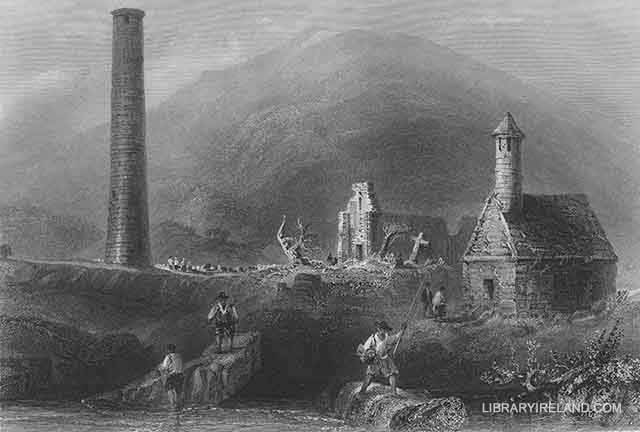Round Tower at Glendalough, County Wicklow
Of the religious edifices of Glendalough, the Cathedral, which owes its origin to St. Kevin, claims precedence. It was of small dimensions, being no more than forty-eight feet in length, and thirty in width; the architecture was of the rudest style, and almost destitute of ornament. This building is now little better than a heap of ruins. Adjoining the cathedral is a small, dilapidated structure, called "The Priests'-house" which was probably the sacristy where the priests' vestments and the reliques were preserved. A miraculous property of preventing future headaches has been attributed to this building—the individual wishing to obtain this immunity being required to turn himself three times round in the closet, with an entire faith in the power of the blessed St. Kevin.
Of the many crosses scattered amongst these ruins, a remarkable one, which stands in the spacious cemetery, eleven feet in height, and formed of a single block of granite, has also some miraculous qualities attached to it. To obtain the benefit of these, it is necessary that the supplicant should so completely embrace the cross that his hands shall meet on the opposite side. A stranger naturally approaches the front of the cross, and endeavours to perform the required ceremony, but from the great breadth of the stone he is unable to unite his hands on the other side. The guides, however, for a small fee undertake to remove this difficulty, by causing the person making the attempt to change his position, and by placing him close to the narrow side of the shaft, enable him to accomplish his design without any trouble.
Within the walls of the cemetery stands THE ROUND TOWER, one hundred and ten feet in height, uncommonly well built and in fine preservation, the roof alone having suffered by the hand of time. The contrast which this lofty monument of Pagan sepulture offers to the humble headstones which mark the resting-places of the Christian dead, must awaken a train of interesting ideas in every reflective mind. The poetic fancy of Mr. Otway dwelt with peculiar pleasure upon this scene. "I would rather ponder," says he, "on such a spot as this at Glendalough, surrounded as it is with mighty mountains, dark winding glens; all its lakes, streams, rocks, and waterfalls, in keeping and accordant association with a place of ruins—ruins that testify of altars, and of a priesthood overthrown—a worship made desolate—a people 'scattered and peeled,' where the long continuous shadow of the lofty and slender round tower moves slowly from morn to eve over wasted churches, scattered yew-trees, and the tombs, now undistinguishable, of bishops, abbots, and anchorites, walking its round as time-sentinel, and telling forth to the Ancient of Days how many suns have run their diurnal and annual course since these holy men had descended to their graves."
The small building with the miniature of a Round Tower at one end, shown by the artist on the right-hand side of the accompanying engraving, popularly but incorrectly called St. Kevin's Kitchen, is now the most perfect of the Seven Churches: the roof, which is very curious, is composed of thin stones laid horizontally, and rising in the form of a wedge to an acute angle, the extreme height being about thirty feet. The remarkable round belfry, which springs from the west end of the church, is forty-five feet in height, the roof, like that of the church, is formed of thin stones, very neatly laid. A groove that has been discovered cut in the east end of the building shows that this was not the original round tower, which there is reason to suppose was a distinct structure from the church, the latter being erected so as to incorporate with the edifice.

